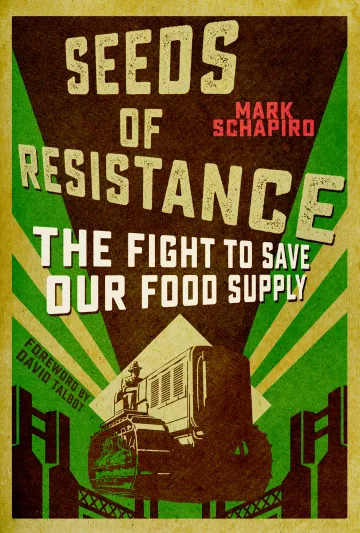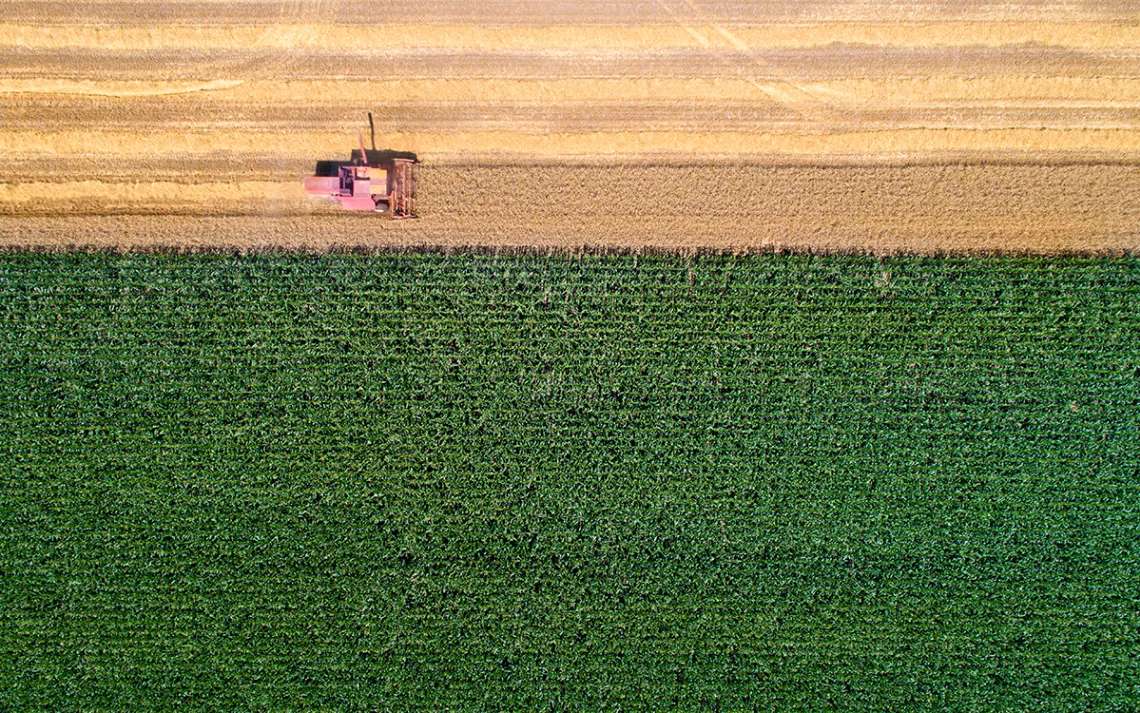Recoupling the Farm and the Environment Around It
Journalist Mark Schapiro on the fight to save our food supply

A seed is never just a seed, writes Mark Schapiro in his new book, Seeds of Resistance (Hot Books, September 2018). “Like all environmental stories, start with a seed and you quickly end up in the realms of money and power—who has it, and who’s struggling to gain or regain it.”
As an environmental journalist, Schapiro has long grappled with our world’s systems of power and economics. His most recent books, Carbon Shock and The End of Stationarity, dive into the repercussions of climate change on global economic systems. Before that, he peeled back the layers of the chemical industry in Exposed and Circle of Poison.
But throughout his career, Schapiro never strayed far from farmers and the seeds on which they depend. In Seeds of Resistance, he recalls a magazine assignment from the early 1980s that brought him from his home base on the Pacific coast to the American heartland. He met with an Iowan farmer who hadn’t yet seen the ocean, which made Schapiro realize that he had never until that moment been on a functioning farm. “Each of us was missing something fundamental about life on Earth,” he writes. “I was as profoundly distanced from the sources of my food, as I suspect are most people.”
From then on, Schapiro writes, he would try to understand the pressures farmers face in a constantly changing world. And that, in time, brought him to seeds, the “canaries on our climate disrupted planet.”
In Seeds of Resistance, Schapiro pokes holes in the unresilient world of industrial agriculture, and the chemical and seed companies that control it, in an era of extreme climatic shifts. At 152 pages, this book is highly compact and digestible, much like the seeds that—with the right amount of sun, soil, and water, and no small amount of diversity—can save our future food supply.
Sierra: What inspired you to take on this project about seeds?
Mark Schapiro: Climate change is dramatically altering the conditions for growing food. Food-growing areas are experiencing volatility, showing an extreme vulnerability in the industrial agricultural system. Yields are starting to drop. The need to apply ever more chemicals and herbicides to sustain crops is increasing. The ability to withstand drought and extreme weather events, all phenomenons of climate change, is weakened when all the crops come from the same kind of seed and they’re all reliant on a fixed set of chemicals.
Biodiversity has always been central to a healthy food system and healthy planet. That’s not a new idea. But climate change intensifies its importance. We need seeds that have the capacity to evolve into dramatically shifting conditions. The industrial seeds don’t have that capacity. I thought I was writing a book on seeds. I was actually writing a book on biodiversity.
You dedicate at least a chapter to the work of two scientists in particular: Nikolay Vavilov and Luther Burbank. Who are they, and what did they contribute to this topic of seeds and biodiversity?
Vavilov is my favorite character. In my head, this project was at first going to be his biography. He is so important and, for many people, an unheralded scientist. He was a Russian botanist in the late 19th and early 20th centuries, and the first deeply scientific botanical explorer to go around the world searching for genetic material. Russia has always been challenged with extremely harsh weather, a constant challenge to their agricultural system. The czar asked a young Vavilov to find genes that could make their crops hardier in winter. When the Bolsheviks took over, rather than cutting his head off, they elevated him and gave him his own lab. He traveled the world and created essentially the biggest seed depository in the world at that time. He was also the first to identify “centers of origin” for many seeds—basically areas where you could obtain genetic resources necessary for adaptation. These areas are still called Vavilov Centers.
While Vavilov was traveling the world looking for new genetic material, Luther Burbank was in Santa Rosa breeding new types of vegetables and fruits. He created a farm and seed-breeding operation. The pluot is a Burbank concoction. There were thousands of years of native agriculture and individuals working with seed evolution, but I thought of these two men as the first to create a scientific bedrock of why biodiversity is important in seeds.
So our established agricultural system hasn’t really honored their legacy.
Correct. We did exactly the opposite. I use them as lodestars for the basic principles of seed diversity, and for basically how far we’ve fallen from the the vision these two men shared.
What factors have worked against the biodiversity they promoted?
Every time you talk about food and agriculture and seeds, it’s always a question of “we need to feed the hungry.” This has been an argument for decades for massive farms drenched in chemical boosters to feed the world. The notion of a “starving African” is a meme to rationalize the forms of agriculture that are destructive to the environment, have enormous collateral damage on people’s health, and coincide perfectly with the interests of the major chemical and seed companies. I call that the moral fig leaf used to justify a model that increasing evidence suggests is not the best way to increase food, setting aside that these huge industrial farms sit right next to populations of hungry people. You don’t have to go far to see that. Look at the Central Valley of California, a huge breadbasket right next to communities of people who barely have enough to buy lunch and dinner for themselves and their kids.
There’s also the consolidation of seed companies that began in the 1970s and accelerated in the mid to late '80s, when chemical companies started buying seed companies. As smaller, local seed companies were bought out, the bigger mother companies would eliminate the locally bred varieties and replace them with seed varieties that were intended to grow over massive scales of land, with the assistance of increasing amounts of pesticides and herbicides and chemical boosters. Seeds that had evolved to particular locations and conditions were replaced by these big blockbuster seeds. This reduces biodiversity. Put aside for a half second—but only for a half second—the public health concerns of pesticides and herbicides that are toxic for farmworkers and the question is, how do these mass seeds adapt to the circumstances of climate change?
In your book, you pose this very question to an executive at Monsanto Ventures, who told you, “We work to uncouple the farm from the environment around it.” What did she mean by this?
This has to be clear: Monsanto and the other big chemical and seed companies know that climate change is happening. They are not deniers. But of course, they are trying to control the response to climate change. I had asked her how Monsanto is trying to respond to climate change in their seed-breeding programs, and she told me that their breeding aims to uncouple the farm from its environment, which is based on the principle that you can control all of the environmental factors that influence the development of a seed into a plant, and that you can essentially create broadly identical conditions in every field and breed seeds for a set of external inputs—agra-chemicals like chemical fertilizers, chemical pesticides, chemical herbicides—and reproduce those conditions over and over and over again, which are distinct from the actual conditions in which crops are growing.
When she said that they work to “uncouple the farm from the environment around it,” I thought, "Well, that pretty much encapsulates the industrial agriculture system." My book suggests that there’s an accumulating body of evidence that suggests that uncoupling the seed from nature is precisely the wrong approach when it comes to dealing with climate change.
You write that “to document unfair and unjust abuses of power is a first step toward change.” What do the next steps look like in the fight to save our food supply?
I had to decide on one place to go for a book like this, on agriculture and food in the era of climate change, based on my very limited travel budget as an independent journalist. I decided to go to Arizona. Arizona is a big center of industrial agriculture, and it has the conditions now that many food-growing parts of the world are starting to resemble. And I think Arizona is the future of agriculture in these highly stressed circumstances.
In Arizona, you can see two things happening. You can see the stress that’s starting to build on the huge industrial fields, particularly around Yuma. And then there are other fields in other parts of the state taking a more agroecological approach to farming: more organic material in the soil, diverse seed populations, smaller farms that are more attended to by individuals rather than mass farms by absentee owners. I met up with scientist Gary Nabhan, who’s been researching desert agriculture for 20 years. And guess what, desert agriculture is something we’ve got to get used to. Nabhan has an experimental farm where he’s growing food in the midst of this high desert. But he’s also working with a lot of Native people. The American Southwest is the oldest cultivated area of North America. The Indigenous people have been growing food there for thousands of years. That was a powerful revelation for me, when I realized what Native Americans can tell us about growing food.
The guys at Native Seeds/SEARCH in Tucson have been saving southwestern seeds because they believe that contained in those seeds are important genetic information. Seeds are a genetic resource. These genes have evolved over thousands of years, or they’ve been bred or hybridized. Either way, they are genes. For this book, I explored who controls this resource, and it turns out there’s a fight over this very question.
 The Magazine of The Sierra Club
The Magazine of The Sierra Club




